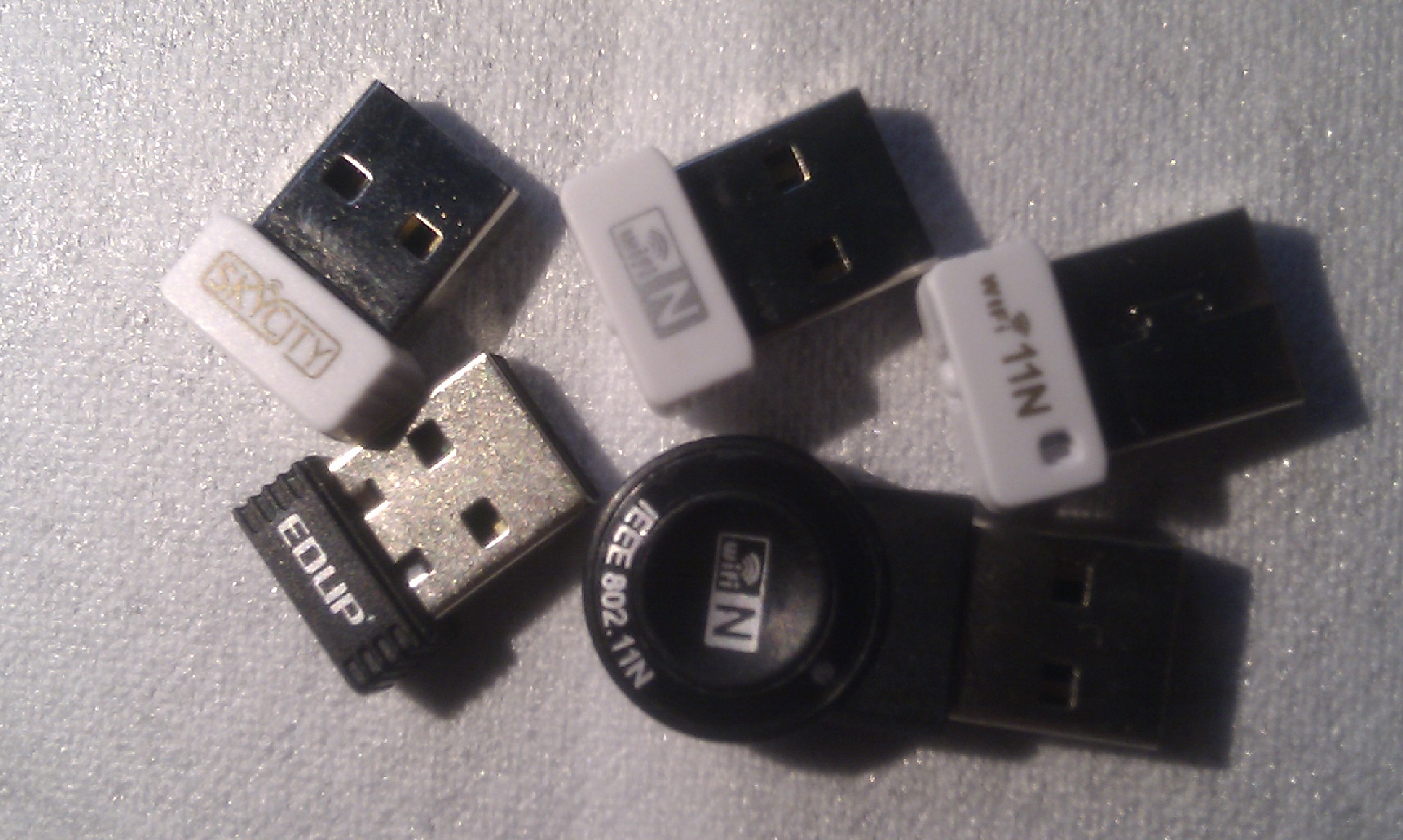| Version 6 (modified by , 14 years ago) ( diff ) |
|---|
Introduction
My idea was to use multiple RTL8188CUS (Realtek Wireless Chipset, 802.11b/g) units to build a cheap WiFi stumble using Kismet without the need of hopping channels. If you do not hop you can scan more bands and capture more useful output when wireless heatmapping.
The Realtek RTL8188CUS comes in many shapes and forms as show on the right. They include labels like:
- WiFi 11N
- EDUP
- IEEE 802.11N
- WiFi N
Comparison
Pro
- The Linux driver is found at Realtek Website
- Unit is cheap: DX sells them for less than 5 EUR.
Cons
- The driver does not handle multiple cards at the same time.
- No driver support for BSD derivatives.
- Kismet does not seems to support this devices.
- The 802.11N description is properly not valid, nor the driver neither the specifications report this functionality.
Conclusion
- The units are currently not usable for the Wireless Heatmap Multiple Cards project.
Appendix
lsusb -vvv
rvdzwet@bunty:~$ sudo lsusb -s 1:15 -vvv
Bus 001 Device 015: ID 0bda:8176 Realtek Semiconductor Corp.
Device Descriptor:
bLength 18
bDescriptorType 1
bcdUSB 2.00
bDeviceClass 0 (Defined at Interface level)
bDeviceSubClass 0
bDeviceProtocol 0
bMaxPacketSize0 64
idVendor 0x0bda Realtek Semiconductor Corp.
idProduct 0x8176
bcdDevice 2.00
iManufacturer 1 Realtek
iProduct 2 802.11n WLAN Adapter
iSerial 3 00e04c000001
bNumConfigurations 1
Configuration Descriptor:
bLength 9
bDescriptorType 2
wTotalLength 46
bNumInterfaces 1
bConfigurationValue 1
iConfiguration 0
bmAttributes 0x80
(Bus Powered)
MaxPower 500mA
Interface Descriptor:
bLength 9
bDescriptorType 4
bInterfaceNumber 0
bAlternateSetting 0
bNumEndpoints 4
bInterfaceClass 255 Vendor Specific Class
bInterfaceSubClass 255 Vendor Specific Subclass
bInterfaceProtocol 255 Vendor Specific Protocol
iInterface 0
Endpoint Descriptor:
bLength 7
bDescriptorType 5
bEndpointAddress 0x81 EP 1 IN
bmAttributes 2
Transfer Type Bulk
Synch Type None
Usage Type Data
wMaxPacketSize 0x0200 1x 512 bytes
bInterval 0
Endpoint Descriptor:
bLength 7
bDescriptorType 5
bEndpointAddress 0x02 EP 2 OUT
bmAttributes 2
Transfer Type Bulk
Synch Type None
Usage Type Data
wMaxPacketSize 0x0200 1x 512 bytes
bInterval 0
Endpoint Descriptor:
bLength 7
bDescriptorType 5
bEndpointAddress 0x03 EP 3 OUT
bmAttributes 2
Transfer Type Bulk
Synch Type None
Usage Type Data
wMaxPacketSize 0x0200 1x 512 bytes
bInterval 0
Endpoint Descriptor:
bLength 7
bDescriptorType 5
bEndpointAddress 0x84 EP 4 IN
bmAttributes 3
Transfer Type Interrupt
Synch Type None
Usage Type Data
wMaxPacketSize 0x0040 1x 64 bytes
bInterval 1
Device Qualifier (for other device speed):
bLength 10
bDescriptorType 6
bcdUSB 2.00
bDeviceClass 0 (Defined at Interface level)
bDeviceSubClass 0
bDeviceProtocol 0
bMaxPacketSize0 64
bNumConfigurations 1
Device Status: 0x0000
(Bus Powered)
Attachments (1)
- RTL8188CUS-devices.jpg (697.9 KB ) - added by 14 years ago.
Download all attachments as: .zip
Note:
See TracWiki
for help on using the wiki.

